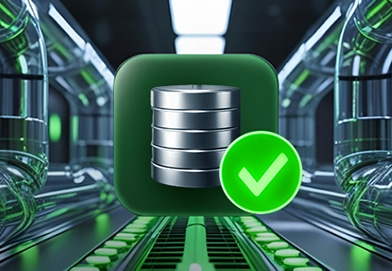A data warehouse is a centralized storage location for structured data from various sources, providing a unified view for analysis and reporting. Its aim is to enhance decision-making, facilitate business intelligence, standardize data integration, optimize performance, ensure data security, and provide a competitive edge.
For businesses, data warehouse development is critical because it enables informed decision-making, empowers business intelligence, introduces data integration and standardization, supports scalability and optimized query performance, ensures regulatory compliance and data security, and leverages data assets to identify trends and opportunities.
In this guide, we will discuss data warehouse design, implementation, management, best practices, challenges, and future trends.
Understanding Data Warehousing

Components of a Data Warehouse
To build a data warehouse, and extract data from various sources while maintaining quality and integrity. Transform, integrate, and structure all the data together for consistency. Store it in a structured format using effective management practices like indexing and compression.
The presentation and analysis layer is the final part of a data warehouse. It enables business users to access and analyze data through BI tools, reporting systems, and data visualization platforms. These tools help extract meaningful insights, generate reports, and facilitate data-driven decision-making.
A data warehouse combines data from different sources, eliminating silos. This creates a cohesive view for better integration of data mining and analysis. It also allows for advanced analytics, user-friendly reports, and timely insights for better decision-making.
Data warehouses are designed to handle large volumes of data efficiently. They provide scalability options, enabling businesses to accommodate growing data storage needs. Data warehousing techniques such as indexing and query optimization enhance performance, ensuring faster data retrieval and analysis.
Understanding the differences between data warehousing, data lakes, and data marts is crucial. A data warehouse integrates data from various sources and supports complex analytics. A data lake stores large volumes of structured, semi-structured, and unstructured data. Allowing data to have flexibility and scalability. Data marts are specialized relational databases, that provide targeted insights for specific user groups. Contact us to learn more.
Designing a Data Warehouse

Data Modeling for Data Warehouses
Dimensional modeling is a popular technique used in the data warehousing process. It involves structuring data in a way that simplifies analysis and reporting. Dimensional models consist of fact and dimension tables, which capture a business process’s metrics and context.
Fact tables contain quantitative and measurable data points, also known as facts, that represent business events or transactions. They are linked to dimension tables through keys, allowing for detailed analysis and reporting by dimensions such as time, geography, or product.
The star schema is a simple and widely used dimensional modeling technique. It consists of a central fact table surrounded by de-normalized dimension tables, forming a star-like structure. This schema simplifies query complexity and improves query performance.
On the other hand, the snowflake schema extends the star schema by normalizing dimension tables, resulting in a more normalized data model. This can help reduce data redundancy but may slightly impact query performance.
Mapping Data Objects
Creating a data warehouse involves mapping out data objects and defining their relationships in a physical data model. This improves integration and retrieval, ensuring all necessary information is captured.
Extract, Transform, Load (ETL) Processes
ETL processes start with data extraction from different sources such as databases, spreadsheets, or APIs. Extracting data involves identifying relevant datasets, selecting appropriate extraction methods, and retrieving the raw data back into the ETL pipeline.
Once the data is extracted, it goes through data transformation, and cleaning processes. This includes data validation, data type conversion, data standardization, handling missing values, and removing duplicates. Data transformations ensure data consistency and improve its quality for analysis.
The transformed and cleaned data is loaded into the warehouse. This process involves mapping the transformed data to the appropriate tables and columns within the warehouse schema. Loading can be done incrementally or in batch processes, depending on the data volume and frequency of updates to store data.
Businesses can design a cloud data warehouse that supports efficient data analysis, reporting, and decision-making by employing an effective data model and implementing robust ETL processes.
Implementing a Data Warehouse Solution

On-premises data warehousing development process involves setting up and managing its infrastructure within the organization’s premises. It offers complete control over hardware, software, and data security. However, it requires a significant upfront investment, ongoing maintenance, and scalability challenges.
A cloud-based warehouse leverages cloud computing services to store and manage data. It offers scalability, flexibility, and cost-effectiveness as organizations pay for resources on a usage basis. Cloud data warehouses easily integrate other cloud services and offer built-in security features. They also handle hardware and software maintenance, allowing businesses to focus on data analysis and insights.
A hybrid warehouse combines elements of on-premises and cloud-based architectures. It allows organizations to keep sensitive or regulatory-compliant data on-premises while utilizing the cloud for scalability and cost-effectiveness. Hybrid solutions offer flexibility, data sovereignty, and the ability to leverage the benefits of both environments.
Roles and Responsibilities in Data Warehousing
Data Warehouse System analyst
- Gathers business requirements and designs data models
- Collaborates with ETL developers and ensures data quality and performance optimization
- Provides support to business intelligence teams, documents processes, and trains end business users
Data Architect
- Designs and maintains the data architecture of the data warehouses
- Establishes data integration processes and ensures data security and governance
- Evaluates technologies and makes informed technology decision
ETL Developer
- Designs develops, and maintains ETL processes for data extraction, transformation, and loading
- Handles error handling, monitoring, and performance tuning
- Collaborates with data warehousing systems analysts and database administrator
Business Intelligence Developer/Analyst
- Develops reports, dashboards, and visualizations
- Performs data analysis, supports user training, and gathers requirements
- Ensures compliance with data governance and security measures
Popular Data Warehouse Technologies and Platforms

There are two types of data warehousing tools: traditional and cloud-based. Traditional tools are used for on-premises data warehouses, with robust data management capabilities and extensive data integration features. Cloud-based platforms are specifically designed for cloud environments, offering scalability, high-performance analytics capabilities, easy integration with other cloud services, and built-in security features. When selecting a data warehousing solution, businesses should consider scalability requirements, budget constraints, data integration capabilities, query performance, data availability, security, and the expertise of the IT team. By understanding the different data warehouses, businesses can choose the most suitable solution that aligns with their requirements and long-term strategy.
Data Warehouse Management and Governance
Data governance involves policies and practices to ensure accurate and accountable data management. Data quality management techniques like removing duplicates and standardizing formats improve data consistency. Validation processes like integrity checks verify data accuracy.
Data Security and Privacy Considerations
Data security is crucial for data warehousing. Organizations should implement strict measures to prevent data breaches, and protect sensitive information. Following regulations like GDPR and CCPA, and conducting regular compliance audits is essential.
Access controls limit data access to authorized personnel, while encryption techniques keep data safe from unauthorized access.
Leveraging Data Warehousing for Business Transformation

Business Intelligence and Analytics
Building a data warehouse is a valuable resource for extracting insights from vast amounts of data. Businesses can use data warehousing to uncover patterns, trends, and correlations within the data by leveraging data analytics techniques. This analysis provides valuable insights into business operations, customer behavior, market trends, operational efficiency, and other crucial aspects of the business.
Visualization tools like Tableau, Power BI, and Qlik make data exploration easy with interactive dashboards, charts, and automated reporting for timely decision-making.
Driving Data-Driven Decision-Making
Defining relevant KPIs helps businesses measure their performance and track progress towards goals. A data warehouse provides valuable insights for improvement and growth opportunities.
Data analytics is pivotal in gaining a serious competitive advantage or edge in the market. By leveraging data warehousing, businesses can perform advanced analytics, such as predictive modeling or machine learning algorithms, to identify emerging trends, forecast future outcomes, and make data-driven decisions. This empowers organizations to adapt quickly, optimize operations, and stay ahead of competitors.
Data warehousing enables businesses to collect data, transform data, extract insights, visualize data, and make informed decisions, driving innovation and growth.
Best Practices for Successful Data Warehousing Solutions
Building a Solid Foundation for Data Warehousing
Define clear goals and objectives for your data warehouse project to align with your business strategy. Identify specific problems to solve or opportunities to explore through data analysis. This will guide your data models, your ETL tools and processes, and governance efforts.
Collaborating with stakeholders and experts from different departments is key to developing a successful enterprise data warehouse. Determine the necessary data components, metrics, and dimensions together to improve the usefulness of the enterprise data warehouses.
Continuous Monitoring and Optimization
Monitor your data warehouse performance regularly and identify areas for optimization. Consider factors such as query performance, indexing strategies, data partitioning, and hardware scalability. Continuously tune and optimize your data warehouse infrastructure to ensure efficient data retrieval and processing as the volume of data grows.
Data warehouses require regular maintenance to ensure data integrity and system stability. Perform routine data quality checks, backup and recovery processes, and software updates. Regularly review and enhance your ETL processes to accommodate changes in data sources or business requirements. Proactive maintenance and updates help maintain the reliability and performance of your data warehouse.
Common Challenges and Solutions
Integrating data from different sources can be tough. However with the ETL process, data virtualization, and data integration tools, it can be overcome. Standardizing formats, creating mapping rules, and using transformation techniques are all helpful.
The exponential growth of data volumes and the increasing variety of data types pose challenges for data warehousing. Scaling the data warehouse infrastructure to handle large datasets, data source complexity, and diverse data formats is crucial. Adopting scalable cloud-based data warehouse solutions, implementing data compression techniques, and leveraging distributed computing technologies, such as Hadoop or Spark, address these challenges effectively.
Emerging Trends and Technologies in Data Warehousing

Real-time data warehousing and streaming analytics are increasingly popular for quick insights. Apache Kafka and Amazon Kinesis are two technologies that can help businesses gain real-time insights and take more actionable insights based on them.
Artificial intelligence (AI) and machine learning (ML) are increasingly integrated into data warehousing to make business intelligence tools enhance analytics capabilities. ML algorithms can help automate data preparation, identify patterns, and make predictions based on historical data. AI-powered data governance solutions assist in data quality management and ensure compliance. Integrating AI and ML technologies with a data warehousing solution drives intelligent decision-making and uncovers valuable insights from complex datasets.
Data warehouse development will witness further advancements as the data landscape evolves. Integrating real-time data processing, streaming analytics, and AI/ML technologies will enable organizations to derive deeper insights, automate business processes, and gain a competitive edge in the market.
Let Data Sleek Help
Data Sleek offers tailored data management and analytics solutions for high-performing data warehouses. Our experienced professionals guide organizations through every step of the implementation process, from data modeling to performance optimization. We help businesses select the right solution and prioritize data quality assurance for accurate and reliable insights. Partner with us to streamline your data management processes and drive business growth through data-driven decision-making.
Please reach out to learn more about how we can help!







